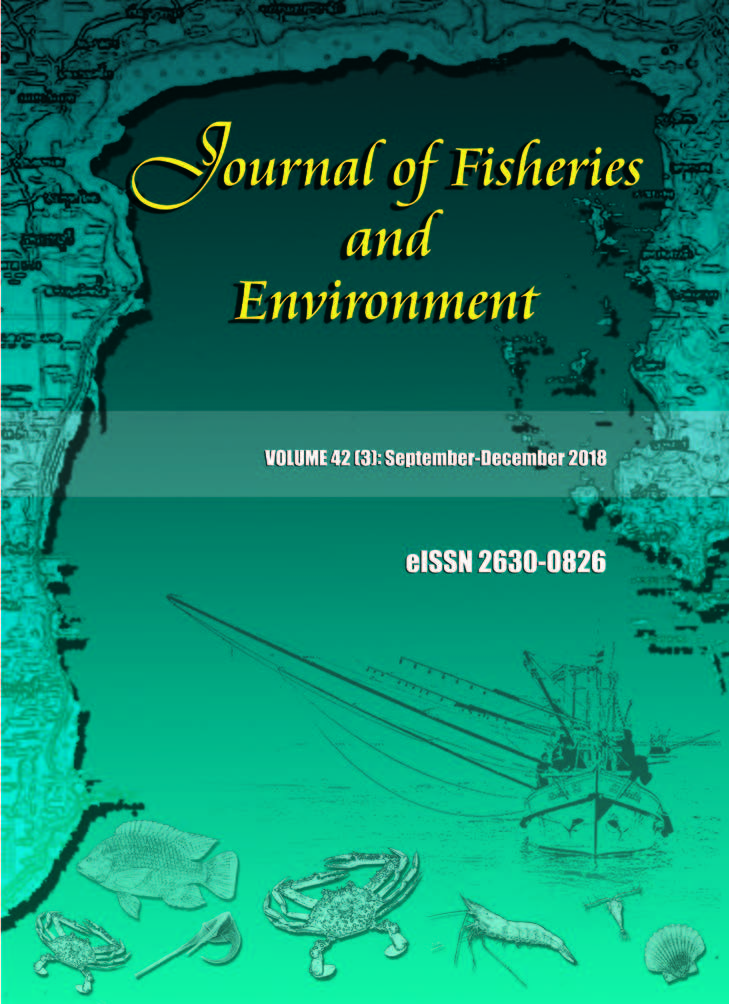Status of Trash Fish from Bottom Trawl Fishery and Utilization in Myeik Township, Tanintharyi Region, Myanmar
Main Article Content
Abstract
Catch data, catch composition and fishing boat information were collected from 281 bottom trawlers and 70 fish carrier boats in Myeik Township, Tanintharyi Region, Myanmar in 2017. Meanwhile 50 fishermen were interviewed for data regarding trash fish price and its distribution. Trash fish statistics were also gathered from Myanmar’s Department of Fisheries of Myeik Township, Tanintharyi Region. Information on trash fish utilization for fishmeal production was also gathered by interviewing four fishmeal factory managers in Myeik Township. In addition, other related information on Myanmar fisheries was reviewed. All information was used to describe the status of trash fish from the bottom trawl fishery and its utilization. Moreover, some management aspects were discussed. From the surveys, a catch composition of 39.16% trash fish, 60.34% marketable fish and 0.50% shrimp was found at the landing site. Information from fishermen showed that all bottom trawlers sold 100% of trash fish to local fishmeal plants, and trawlers provided 55% to 70% of the total trash fish for fishmeal production. Fishmeal produced during 2013 to 2017 was exported as follows: 42.06% to Thailand and 10.67% to Malaysia. Of the remainder, 43.76% was sold in Yangon for aquaculture and animal feed and 3.51% was sold to local animal farms. The data showed that trash fish are among the targeted species of the bottom trawl fishery in Myanmar. Although Department of Fisheries of Myanmar has implemented many measures to control overfishing and to conserve juvenile fishes, fishing for trash fish has not been reduced significantly, because price and demand incentives are high. This situation has led to an increase of new fishing boats in this region. To conserve juvenile fishes of economically important species from trawl fisheries in this area, alternative management approaches are needed.
Article Details
References
2. Chokesanguan B, S. Ananpongsuk, J. O. Dickson, and V. Sulit. 2010. Reduction unwanted catch from trawl fisheries: use of juvenile and trash fish excluder devices as fishing technology solution. Fish for the People 8(1) 21-26.
3. Department of Fisheries. 2017. Fisheries statistics, Ministry of Livestock, Fisheries and Rural Development, Republic of the Union of Myanmar. 91 pp.
4. Endroyono. 2015. Overview of the trawl fisheries socio-economic condition in Indonesia after the second trawl ban. Proceeding of the Regional Workshop on Trawl Fisheries Socio-Economics, 26-27 October, 2015. Vietnam. Food and Agriculture Organization of United Nation, Fisheries and Aquaculture Proceeding No. 50. 2015: 3-37.
5. FAO-NORAD. 2013. Myanmar Ecology Survey, Cruise Report, Food and Agriculture Organization of the United Nation and the Norwegian Agency for Development Cooperation, 2013. EAF – N/2013/9, 100 pp.
6. FAO-NORAD. 2015. Myanmar Ecosystem Survey, Cruise Report, Food and Agriculture Organization of the United Nation and the Norwegian Agency for Development Cooperation, 2015. EAF – N/2015/4, 107 pp.
7. Kaewnern, M. and S. Wangvoralak. 2005. Status of trash fish and utilization for aquaculture in Thailand. Kasetsart Journal (Natural Science) 39: 70–77.
8. Nakken, O. and S. Aung. 1980. A survey of the fish resources of Burma, September-November 1979. Institute of Marine Research, Bergen, Norway. 158 pp
9. Okawara M., P. Masthawee, A. Munprasit, B. Chokesunguan and Y. Theparoonrat. 2004. Fishing Gear and Method in Southeast Asia: I. Thailand (Revisional Edition), South East Asia Fisheries Development Center, Training Department, TD/RES/9, 390 pp.
10. Somboom S. 2010. Enhancing the fisheries resources in Southeast Asian: Recommended approaches. Fish for the People 8(1): 18-20.
11. Staples D. and S. Funge-Smith. 2005. Prized commodity: Low value/Trash fish form Marine Fisheries in the South East Asia Region. Fish for the People 3(2): 6-12.
12. Thapanand-Chaidee, T., U Myint Pe and I. Chanarachkij. 2010. Status of Marine Fisheries Resources in Myanmar Waters: Estimates from Bottom Trawler Survey. Kasetsart University Fisheries Research Bulletin 34(1): 35-48.


